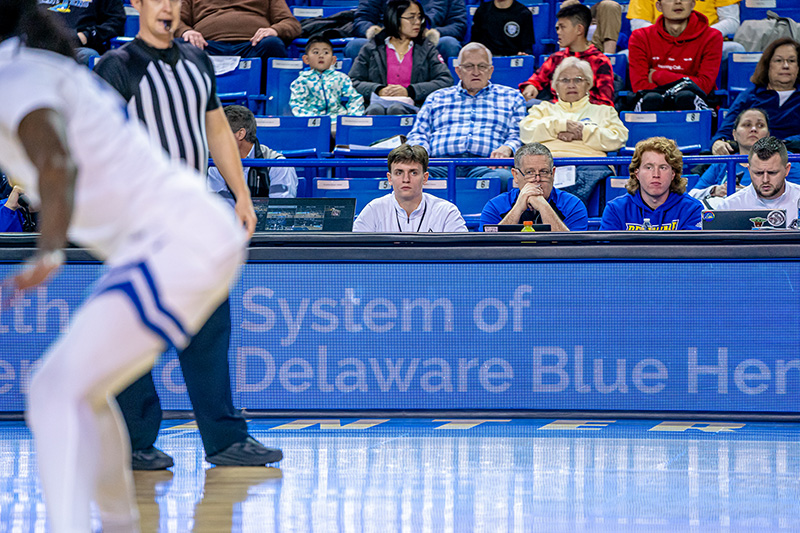


Winning with statistics
Photos by Mikey Reeves and Katie Young April 30, 2025
Statistics major Colin Pié analyzes student-athlete performance through work with UD Athletics internship
Growing up in a family with season tickets to University of Delaware football games and three older brothers to look up to, Colin Pié, a sophomore statistics major at UD, was immersed in sports from a young age.
“My brothers and I were all athletes,” Pié said. “We all played sports throughout high school, and sports is my biggest passion. I'm a huge fan of all professional and college sports, and I love keeping up with my favorite teams.”
As a Delawarean, coming to UD was a no-brainer for Pié, whose older brothers all attended. But although he knew he wanted to attend the University, he wasn’t sure what his path would be, so Pié applied to UD undeclared.
After enjoying his AP statistics class in high school, he gave UD’s statistics major a chance.
“I did well in the course, and I really enjoyed it,” Pié said. “I am also interested in applying my statistical knowledge to sports.”
In order to blend his two interests, Pié earned an internship with UD Athletics. He works to track student-athlete performance in practice based on data from wearable technology and in games with manual data collection.
“Student-athletes wear GPS technology that assists coaches, athletic trainers, and strength and conditioning coaches in practice planning and load management,” said Christina Rasnake, director of UD Athletics Sports Science and Analytics. “Decision-makers can see real-time data such as high-intensity distance, max speed, number of sprints completed and fatigue level to name a few.”
“We attend practices and games and track their repetitions, analyze the data we find and write reports for the coaches to review,” Pié said.
The reports that Pié creates for coaches provide quantitative information on strengths and weaknesses within the team and within each player.
“Take football, for example,” Pié said. “If we go to practice and they are doing a seven-on-seven drill (seven offensive versus seven defensive players), we keep track of information beyond the box score statistics, including depth of target, location of the play on the field, the nearest defender and time of play.”
Using the data gathered during practices and games, Pié can see different trends that appear and analyze how those trends change as the season progresses.
According to Rasnake, internships allow students to get hands-on experience with sports analytics and how to communicate their findings to coaches, athletes and other training staff.

Covering all the varsity teams from football to lacrosse, interns learn how to collect and analyze data from all types of sports. In basketball, interns can identify where players are most efficient at shooting from, while in football they can break down every single quarterback pass.
“We are analyzing every single play and assisting the coaches in finding meaningful feedback,” Rasnake said. “We want to make sure that there’s a worthwhile change that has occurred in assessing players’ development. We're also looking at our ability to compete at a high level at all times, and make sure that our student-athletes are available to play at an optimal level at all times.”
With all this data, it can be hard to sift through and decide what are the most meaningful metrics to report. Sports Science and Analytics interns quickly learn how to generate the most concise reports, with Rasnake emphasizing that interns are taught how to communicate the best-detailed report they can.
Pié is on the path to a successful sports analytics career. With an ability to constantly adapt and learn, the Blue Hen sophomore applies new knowledge to what’s happening in the field.
“Colin is definitely someone who is very intelligent,” Rasnake said. “It’s a testament to his ability to not become complacent with what he knows; he likes to push his limits to be able to continue to develop.”
Pié also works with the UD Athletics communications team, where he is “statting” for various games, calling and inputting every play into the ESPN live statistics system so that an accurate play-by-play of the game is generated.
In addition to his sports-related and statistical pursuits, Pié is heavily involved in the College of Agriculture and Natural Resources, volunteering as an ag ambassador, working as a peer mentor, and serving as the undergraduate representative on the CANR’s Strategic Planning Committee.
Pié's experience as a peer mentor and work with UD faculty members also led to an interest in higher education.
“I definitely want to get my masters. I am thinking specifically of doing statistics 4+1 (B.S.+ M.S.) here at UD, and I would love working in the sports science world after that,” Pié said. “I am also interested in the idea of becoming a professor down the road. Watching my statistics professors, seeing what they do, taking difficult concepts and teaching it to others, is something I would enjoy doing.”
Contact Us
Have a UDaily story idea?
Contact us at ocm@udel.edu
Members of the press
Contact us at mediarelations@udel.edu or visit the Media Relations website

